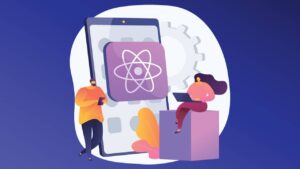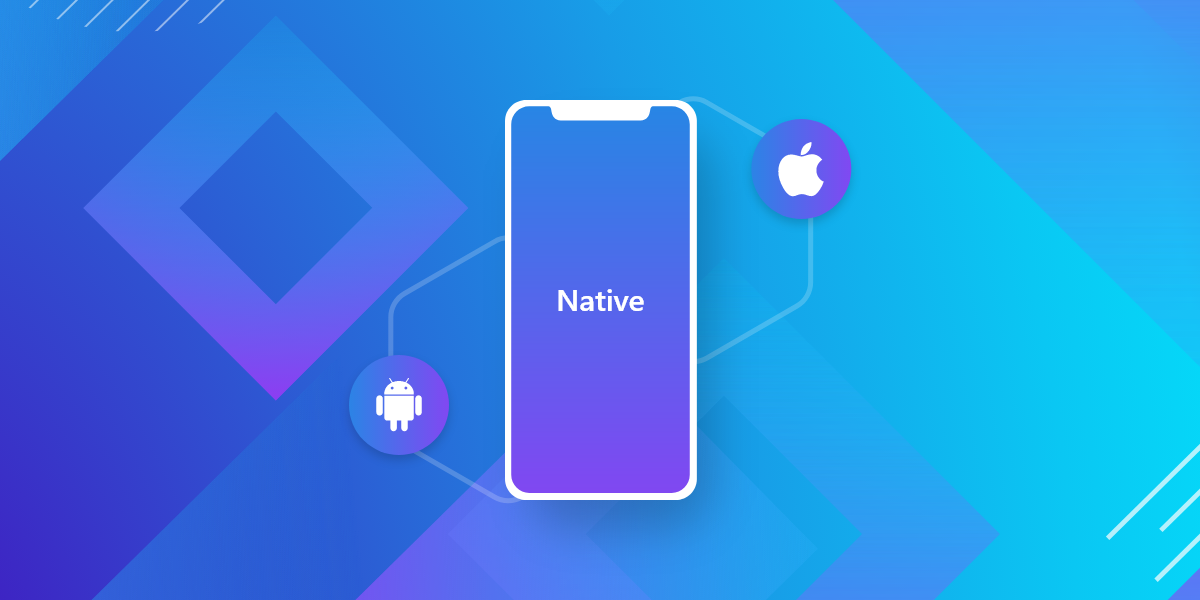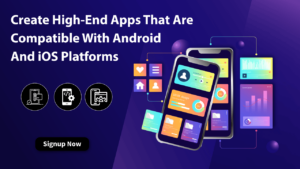With mobile apps now accounting for more than 53% of all web traffic, businesses need to have a well-thought-out plan. Whether you are starting from the ground up or a large organization, it can be challenging to decide whether to go with a native mobile application or cross-platform app development.
As reported by Allied Market Research, the mobile application market is on the rise, with more than 4.4 million apps on Apple’s App Store and Google Play, leading to a projected $407.31 billion growth in value by 2026. To make sure you get your best return on investment, it’s essential to know all of your options when it comes to app development.
As mobile app usage grows, many start-ups are jumping on the bandwagon and pushing out their apps as soon as possible. But what makes native apps so unique? What’s the difference between developing a native application and another mobile application?
In this article, we’ll provide an easy-to-understand answer to all your questions regarding developing single-system applications so that you can create the best possible app!
Native Mobile Development Technologies
Native mobile applications are created to run independently on mobile devices, requiring developers to become knowledgeable in both the language used for the specific operating system and mobile application technology. For instance, Objective-C or Swift is necessary when creating an iPhone app, while Java or Kotlin must be known if building a program for Android.
What is a native app?
Native applications are explicitly tailored to the operating system of mobile devices, such as Android or iOS. The programming targets a specific device’s processor and OS, making it only usable on that particular phone.

These apps tend to be more reliable and faster than hybrid or web applications since they have access to all of the native capabilities like cameras, geolocation, accelerometer, and more. Plus, they require less memory to run efficiently.
Examples of the best native apps
Native applications are designed to run on a specific operating system. The most popular options for this are iOS and Android apps.
-
iOS App Development
The iOS operating system is used to power all Apple’s devices, including the iPhone, iPad, and iPod Touch. It has a stylish design, intuitive user interface, and enhanced security features, making it an economical choice with a great return on investment. An example of a native application that was designed specifically for iOS and then ported to Android is Tinder; its appearance differs markedly between the two platforms.
-
Android App Development
Apart from providing an open-source OS, Android gives developers access to a massive user base – as of 2021, Statista reported that the Google Play Store had seen over 111.3 billion downloads. This is why many of the leading apps are initially developed for Android. Famous examples of native apps include Waze for navigation, Twitter and WhatsApp for social networking, and Pokémon Go for gaming.
Key Benefits Of Native App Development
-
Higher-performance
iOS and Android, native app development is designed to make the most of their respective platforms. From increased performance to access to hardware components like GPS, camera, and touch screen, these apps fully utilize a device’s capabilities. As they are coded with device-specific frameworks in mind, you can trust that your application will run smoothly for the long term.
Native apps can utilize local APIs for additional features and functions. This helps give your app a unique edge in terms of user experience and engagement. Overall, native app development offers the most reliable way to create mobile applications tailored to their respective platforms.
-
Improved security
A key benefit of native app development is the secure platform it offers. Because native apps don’t run in the browser and have no reverse connection, issues like cross-site scripting and SQL injection are eliminated, ensuring your application is safe from any potential vulnerabilities associated with browsers.
Another advantage is that native apps typically use device-specific hardware, such as GPS and camera capabilities, to deliver a more interactive experience for the user. They can utilize device-specific features like push notifications, which can be used to engage users and keep them up to date with the latest news or promotions.
-
Great user experience
Native apps are designed to take full advantage of the underlying platform, allowing them to interact with the operating system and other applications smoothly and efficiently. As a result, users can easily pick up how to use the app, resulting in an enhanced user experience.
-
Quick integration of new features
Native app development for Android and iOS can provide access to a more extensive selection of hardware and software components that cross-platform applications. This includes things like accelerometers, cameras, GPS, barcode scanners, NFC readers, or speech recognition on the software side. Hardware features may include such items as well.
Difference Between Native and Cross-Platform App Development
With the ever-increasing number of mobile phone users, it has become increasingly difficult for app developers to capture their attention in the crowded market. To ensure that your application remains competitive and relevant, you may need to decide between building a native mobile app or a cross-platform solution.
Native Apps
Native applications are designed exclusively for a specific platform, considering the unique features of that operating system (OS). These apps use native graphical user interfaces (GUIs) and tools integrated with the OS, including its design, feel, and other components.
The demand for native mobile app development is overgrowing among businesses and developers. The main reason is that native applications offer a superior performance that web-only or cross-platform apps cannot achieve. They provide an excellent user experience.
Cross-Platform Apps
Cross-platform app development offers many benefits, such as creating a single app that functions on multiple platforms. In comparison to creating separate apps for each platform, cross-platform development is much more efficient and cost-effective. When considering which tools to use for this task, developers can look into Flutter, React Native, and Xamarin. However, it should be noted that cross-platform apps may only sometimes run as smoothly as natively developed ones since they need to be customized for each platform and operating system.
Hence, when quality is of the utmost importance, a native app might be more suitable.
Top Cross-Platform App Frameworks

There are many frameworks to choose from for cross-platform mobile application development. Let’s take a look at three of the most popular ones:
-
Flutter
Flutter is an open-source mobile development framework developed by Google, which allows developers to create native Android and iOS applications from a single codebase. It has only been around for less than two years but has quickly gathered a large fanbase, as it is considered one of the best platforms available. In this article, we’ll explore what makes Flutter unique and special by looking at its features. One of these is the Hot Reload feature, which instantly applies changes made to the code without rebuilding the entire application – allowing for quicker development and saving time.
Widgets are like the building blocks of Flutter and allow you to customize your app’s user interface by creating, configuring, and customizing objects that extend the Widget class. With Flutter, developers can maximize their code reuse across iOS, Android, and web platforms with a single codebase. This fast-issuing framework helps developers create modern mobile apps for any platform quickly and efficiently.
-
React Native
React Native is a Javascript framework that was initially developed at Facebook to create mobile applications. It enables developers to construct cross-platform apps with only Javascript, eliminating the need to write separate code in Objective-C or Java. This way, one can build an app that performs like a native application.
Its main benefits include:
- Its speed.
- The possibility of reusing code between various platforms.
- A high API performance and accuracy level.
Many mobile apps have been built using React Native, such as Artsy, Bloomberg, and Delivery.com.
-
Xamarin
Xamarin is still a popular solution for mobile app development, allowing developers to create iOS, Android, and Windows Phone applications. One of its significant advantages is code reusability; this increases code sharing by up to 80%. This not only allows teams to work more efficiently but also helps them to produce better results with fewer mistakes.
In 2019, Xamarin was a key trend in software development. However, its popularity has been waning over the last year. While Xamarin is still widely used today, new trends have emerged, and old ones have become obsolete. Nevertheless, it’s still one of the top application development toolkits available.
Build A Native App With Mobiroller
Mobiroller is a powerful native mobile app development platform that allows developers to quickly and easily create apps for iOS and Android. It offers comprehensive features such as an intuitive user interface, code reusability, support for multiple languages, integration with third-party APIs, secure cloud storage, and more. Its drag-and-drop feature makes it easy to customize your app’s design, layout, and features.

With Mobiroller’s analytics tool, you can measure user engagement and track performance metrics. Overall, cross-platform and native app development offers unique benefits depending on the needs of each project. Making an informed decision will help you build a successful
mobile app. With the right platform and a reliable team, you can create a unique mobile experience for your users.
QUESTIONS AND ANSWERS
Q: What are the benefits of using Flutter for mobile app development?
A: Flutter allows developers to maximize code reuse across iOS, Android, and web platforms with a single codebase. It also helps developers create modern mobile apps quickly and efficiently.
Q: What is React Native used for?
A: React Native is a mobile app development framework initially developed at Facebook to create mobile applications. It enables developers to construct cross-platform apps with only Javascript, eliminating the need to write separate code in Objective-C or Java.
Q: What are the features of a Mobiroller?
A: Mobiroller is a powerful native mobile app development platform that allows developers to quickly and easily create apps for iOS and Android. It offers comprehensive features such as an intuitive user interface, code reusability, support for multiple languages, integration with third-party APIs, secure cloud storage, and more. Its drag-and-drop feature makes it easy to customize your app’s design, layout, and features. With Mobiroller’s analytics tool, you can measure user engagement and track performance metrics.
Q: What are the advantages of native app development?
A: Native mobile apps generally provide better performance than their cross-platform counterparts. They also offer device-specific features such as access to the camera, microphone, and other sensors. Additionally, native app development allows developers to use the latest technologies, such as Apple’s ARKit or Google’s Motion Sense. These features can create immersive experiences and make apps more engaging for users.
Q: What should I consider when choosing a mobile app development platform?
A: When choosing a mobile app development platform, you should consider the features and capabilities that it provides, its scalability, the cost of development, and the level of support offered. You should research and find a reliable team to help you create a unique mobile experience for your users. Ultimately it is up to you to choose the platform that best fits your needs.
CONCLUSION
When it comes to mobile app development, there are several platforms available that can help you create a successful application. Flutter, React Native, and Xamarin are some of the most popular. Each platform offers unique features and benefits, but ultimately it is up to you to choose the one that best fits your project’s needs. Mobiroller is an excellent option for native app development as it offers an intuitive UI, secure cloud storage, and analytics. Whichever platform you choose, research and work with a reliable team to ensure that you create the best mobile experience possible. With the right platform and team in place, you’ll be able to create an excellent mobile application that meets the needs of your users.







